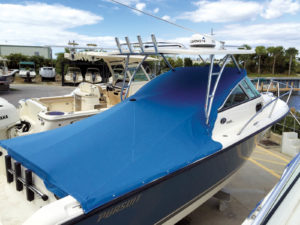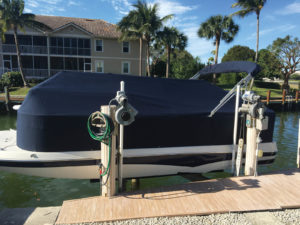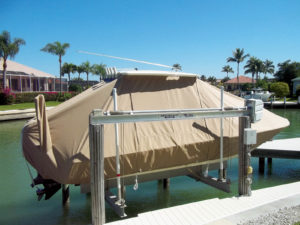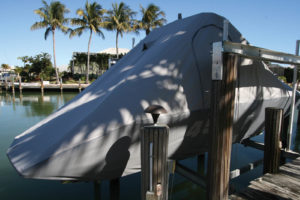Beyond process improvement

The award-winning fabrication projects pictured here reflect the commitment to quality that management and employees at Marco Canvas bring to their work.
Marine fabricator amps up teamwork and quality results
There is a common thread with custom manufacturing—it’s very labor-intensive, very expensive and typically done by artisans and skilled trades people,” says Ed Skrzynski, owner of Marco Canvas, Marco Island, Fla.
“When I took over the company from my father, I asked myself if I could successfully transition it to some level of automation, [and] increase documentation, organization of work flow and product consistency. The answer was yes.”
Skrzynski’s father (Ed Sr.) launched Marco Canvas in the 1970s and centered the business on auto trimming, hospitality and upholstery, with growing segments that focused on the marine and shade markets. By the time Skrzynski took over the business in 2008, its primary market segments had become marine, upholstery and shade systems, the economy was faltering, and he realized that to make any money he needed to implement process improvements he acquired from his previous work in heavy industrial manufacturing—which essentially meant changing the way just about everything was done. “Everything has changed at Marco Canvas,” Skrzynski says. “It’s an entirely different company. Sometimes I wonder if it would have been easier to start fresh, except for the fact that we maintained our customer base.”
 Production, reorganized
Production, reorganized
Skrzynski began by examining work flow and implementing a custom digital production system. “Before [I implemented process improvements] each project was typically done by one skilled tradesperson from start to finish,” he says. “The network was very labor-intensive and required a great amount of skill without too much thought about the business aspect. The focus was more on individual projects by the individual working on them and a little teamwork.”
While Skrzynski knew the basics of textile fabrication, he had to do a significant amount of research on digital production processes before deciding what equipment to invest in.
“I had three tradesmen working for me and based on observation of their work, my brother and I were able to put together an automated production line that included 2-D and 3-D patterning and CAD, shape analysis software and CNC cutting and plotting,” he says. “Now, no one person in the company holds the key to
the job. We are a team.”
 Along with that team approach and growth came the need for middle management. Skrzynski has added a digital design manager who supervises the cutting operator and CAD and patterning personnel; a metal fabrication manager who oversees the welding, metal bending and assembly, powder coating and installation of metal-related objects; a sewn goods manager who manages textile fabrication; and an office manager who handles administration. “You can’t be omnipresent,” Skrzynski says. “So when we reached a critical mass of staff, we promoted middle management from our current team.”
Along with that team approach and growth came the need for middle management. Skrzynski has added a digital design manager who supervises the cutting operator and CAD and patterning personnel; a metal fabrication manager who oversees the welding, metal bending and assembly, powder coating and installation of metal-related objects; a sewn goods manager who manages textile fabrication; and an office manager who handles administration. “You can’t be omnipresent,” Skrzynski says. “So when we reached a critical mass of staff, we promoted middle management from our current team.”
Skrzynski also began using process travelers to act as a guide for each job and honed communication. He color-coded the different stages of production, such as green for estimating, purple for patterning, black for installation and red for sewing. Each project is written on a dry erase board using the corresponding color that represents what stage the project has reached. Each stage also has its own color-coded paperwork, so as the project moves through production, the team can visually communicate and see the current stage of any job.
 Writing the book on process
Writing the book on process
To ensure consistency and quality, Skrzynski created a standard operating procedure manual. Organized by department, the manual is currently more than 100 pages long. It includes everything from how to answer the phone and how to ask follow-up questions on sales to how to run the cutting table, do photogrammetry (taking measurements from photographs) and model in CAD. “The goals for the manual hit on several fronts,” Skrzynski says. “It allows me to work remotely and rely more heavily on the managers; it makes sure that customers are getting the right treatment; and when the day comes that I want to sell the business, it will increase its value—I’ll have more to offer than equipment and a customer base. I will have a book on how to run the company.”
The book is far from a static document. Processes are always being updated; some are eliminated and others added. Each department manager oversees his or her own section. To test the efficacy of each process, Skrzynski brings in someone who has no idea about how to complete whichever process is being tested. “They go through the index, find the proper section and go through it step-by-step,” he says. “We want them to prove or disprove our standard operating procedure. For instance, can they actually do photogrammetry just by following our written and pictorial instructions? That’s how we know if the process needs to be refined.”
 A new paradigm for boat covers
A new paradigm for boat covers
Not only did Skrzynski revamp the company’s processes, he also developed an entirely new concept for covering boats. “One of the things I recognized early on was that customers needed to buy what we call day covers, which they used to cover their boat upholstery—sometimes daily —as well as needing to buy large storage covers for when they need to protect the entire vessel,” he says. “The large storage covers are extremely heavy and cumbersome to put on. So I began to look for an easier way. So I thought: What if I made a cover that was on a rod or cable?”
That idea eventually became the Liberty Cover System™, a patented retractable boat covering system—but the process was not without its challenges. The cost and navigating the legal system were difficult, to say the least. “Part of our patent was contested after the patent was issued, so we had significantly more legal fees at that point,” he says. “Differences in municipalities were also an issue. We had to do our due diligence to understand various local codes and attain certifications of the system’s wind speeds and kinetic energy loads.”
Like most products, the Liberty Cover undergoes constant changes. Some changes have been based on Skrzynski’s own boating experiences, and others have been based on customer feedback. Some changes have made the product easier to use and others are add-ons, such as adding shore power access through the cover, hurricane tie-downs and a variable height system.
Despite the challenges, developing and patenting the product was a successful endeavor. And while patenting the product may have been the right decision for the Liberty Cover, it’s not always the best route to take, Skrzynski advises. “Whether or not to patent depends on the valuation of the idea,” he says. “What you truly believe the market value is of the product is going to determine whether you should get a patent. It can be expensive and very time-consuming, so you’d want to do a risk-to-value analysis.”
Whether it’s automating production, streamlining processes or developing new products to bring to market, Skrzynski relies on his analytical skills—and his skilled team—to break down the problem and build a solution.
Sigrid Tornquist is a St. Paul, Minn.-based writer and editor.
 TEXTILES.ORG
TEXTILES.ORG 






